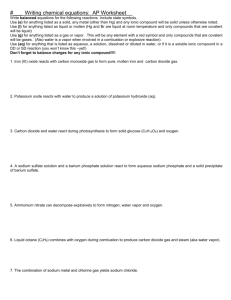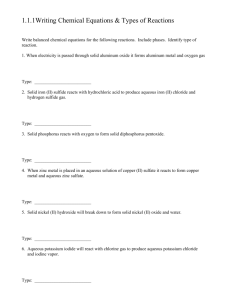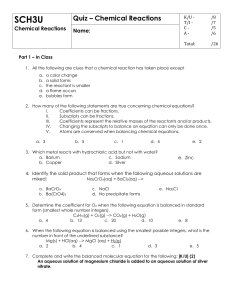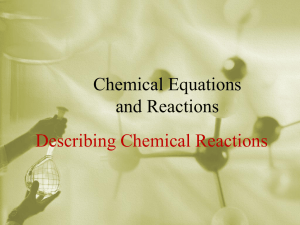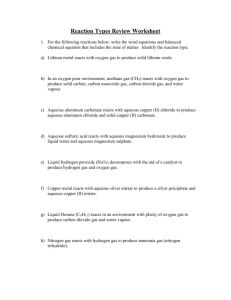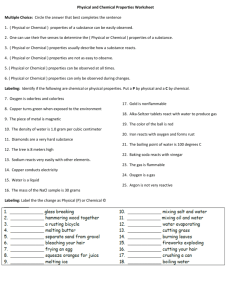Writing Formula Equations Assignment
advertisement
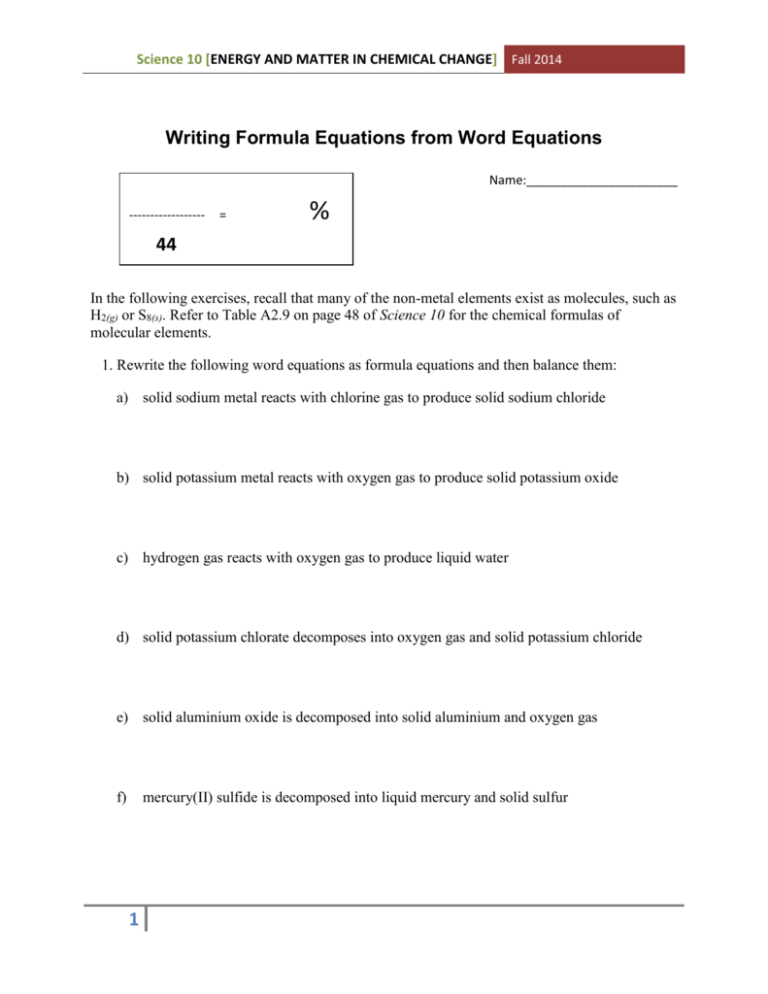
Science 10 [ENERGY AND MATTER IN CHEMICAL CHANGE] Fall 2014 Writing Formula Equations from Word Equations Name:______________________ ------------------ = % 44 In the following exercises, recall that many of the non-metal elements exist as molecules, such as H2(g) or S8(s). Refer to Table A2.9 on page 48 of Science 10 for the chemical formulas of molecular elements. 1. Rewrite the following word equations as formula equations and then balance them: a) solid sodium metal reacts with chlorine gas to produce solid sodium chloride b) solid potassium metal reacts with oxygen gas to produce solid potassium oxide c) hydrogen gas reacts with oxygen gas to produce liquid water d) solid potassium chlorate decomposes into oxygen gas and solid potassium chloride e) solid aluminium oxide is decomposed into solid aluminium and oxygen gas f) mercury(II) sulfide is decomposed into liquid mercury and solid sulfur 1 Science 10 [ENERGY AND MATTER IN CHEMICAL CHANGE] Fall 2014 g) aqueous cobalt(III) nitrate reacts with solid zinc to produce aqueous zinc nitrate and solid cobalt h) fluorine gas reacts with aqueous lead(IV) iodide to produce aqueous lead(IV) fluoride and solid iodine i) aqueous gold(III) bromide reacts with solid silver metal to produce solid silver bromide and solid gold metal j) aqueous sodium sulfate reacts with aqueous strontium hydroxide to produce aqueous sodium hydroxide and solid strontium sulfate k) aqueous thallium(I) hydroxide reacts with aqueous magnesium bromide to produce solid magnesium hydroxide and solid thallium bromide l) methane gas reacts with oxygen gas to produce carbon dioxide gas and water vapour 2 Science 10 [ENERGY AND MATTER IN CHEMICAL CHANGE] Fall 2014 In the following exercises, some states need to be determined, and some chemical formulas need to be looked up or remembered. States: - All metals, except Hg(l), are solids at room temperature - All ionic compounds are solids at room temperature. - If an ionic compound that is very soluble is present in water, then its state is shown as aqueous. However, if it is slightly soluble, then its state is shown as solid, even if it is in water. Refer to the solubility table, Table C, in on Student Reference 12 of Science 10 to determine the state of ionic compounds in water. Formulas: - Table A2.11 on page 49 Science 10 contains a list of common molecular compounds containing hydrogen. - Table A2.17 on page 65 Science 10 contains a list of names and formulas of common acids. 2. Rewrite the following word equations as formula equations and balance: a) magnesium metal reacts with liquid bromine to produce magnesium bromide b) solid sulfur and hydrogen gas react to produce hydrogen sulfide gas c) methane gas reacts with liquid water to produce liquid methanol and hydrogen gas d) aqueous copper(II) chloride reacts with nickel metal to produce copper metal and nickel(III) chloride e) aqueous barium chlorate reacts with aqueous cesium sulfate to produce cesium chlorate and barium sulfate 3 Science 10 [ENERGY AND MATTER IN CHEMICAL CHANGE] Fall 2014 f) a potassium carbonate solution reacts with a sodium chloride solution to produce potassium chloride and sodium carbonate g) solid sucrose burns in oxygen gas to produce carbon dioxide gas and water vapour h) aqueous hydrogen peroxide decomposes into oxygen gas and water i) hydrochloric acid reacts with aqueous sodium hydroxide to produce aqueous sodium chloride and water j) sulfuric acid reacts with solid aluminium hydroxide to produce aluminium sulfate and water 4

